TSUKUBA FUTURE
#005 Have You Heard of Xenoturbella?
Assistant Professor NAKANO Hiroaki, Faculty of Life and Environmental Sciences

All living animals are currently divided into approximately 35 phyla. We humans are members of the phylum Chordata, which is divided into three subphyla: tunicates (including sea squirts), cephalochordates (including lancelets), and vertebrates. It seems strange that sea squirts and humans would be grouped together, but sea squirt larvae have a form like tadpoles and swim about freely. Not only the form of the adult, but its process of development is an important clue for the phylogenetic classification of animals. Recently, data from DNA analysis has become an important additional key. The echinoderms (such as starfish and sea cucumbers) and hemichordates (such as acorn worms) have a close evolutionary relationship with the chordates, and together these three animal phyla are known as deuterostomes, animals that developfrom a fertilized egg through a process of blastogenesis, with the anus developing first, then the mouth.

Xenoturbella are strange marine worms about one to three centimeters in length. They have a very primitive structure, without a brain, eyes, bones, or anus. Since their discovery in 1878, very little had been known about their mode of life, and they were long thought to be a "strange" relative of flatworms (platyhelminths, which include planaria). However, in 2003, an academic paper appeared asserting that Xenoturbella were deuterostomes. How could they be, without an anus? Prof. Nakano, who had just taken his PhD. in research on echinoderm sea lilies, was intrigued by the paper and decided to do overseas research in Sweden, the only place in the world where Xenoturbella can be regularly collected. Based on his observations of Xenoturbella and DNA analysis, in 2011 he issued a paper stating that Xenoturbella were members of a new phylum within the deuterostomes that he christened Xenacoelomorpha. In other words, on the basis of classification, Xenoturbella and humans are close relatives. By researching Xenoturbella, one can get to learn more about the evolutionary path taken by humans.
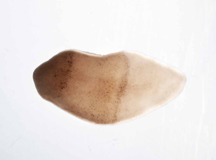
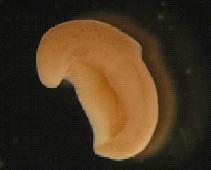
Xenoturbella adult. It actually has left/right and front/back sides.
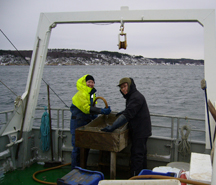
Prof. Nakano gathers Xenoturbella with his wife in the waters of a winter fjord.
Off the coast of Sweden, Xenoturbella are found on the seafloor at depths of around 100 meters. During the winter breeding season, researchers go out in a boat, dredge mud from the seafloor, filter the sediment, and search for the worms by hand. Even then, one might find no more than a few dozen worms in one hunt. After breeding and observing these specimens in the lab, Prof. Nakano was first in the world to observe their elliptical larvae, which do not even have a mouth.
Xenoturbella larvae move the cilia that cover their bodies to swim about through the water. After five days or so, the young begin to crawl around on the seafloor like adults. While Prof. Nakano was able to observe the larvae, there is still much to learn, including the process of hatching from eggs, sexual dimorphism, and how the worms eat.
Currently, Prof. Nakano is at the Shimoda Marine Research Center analyzing data relating to the Xenoturbella he brought back from Sweden. At the same time, he is researching sea lilies and Trichoplax (phylum Placozoa). These are also truly strange creatures, but they can be found in abundance in the seas around Japan. Trichoplax is the sole representative of the phylum, but has also been found at the Shimoda Marine Research Center by Prof. Nakano, and this is the only location in Japan where wild Trichoplax are being studied. The creatures are around one to two millimeters in size, with neither nerve nor muscle cells, making them even flatter and more primitive than Xenoturbella (they are only three cell layers thick). The creature is so simple that classification was difficult, but based on electron microscopy and DNA analysis, the existence of multiple groups has finally been determined. Their developmental process is not fully understood, but they have the strange ability to develop both from eggs and through division, and future research results are awaited.
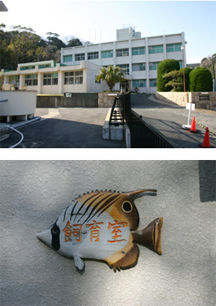
Shimoda Marine Research Center. The signs also have a marine life motif.
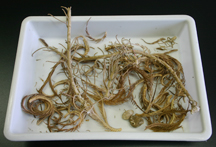
Dried sea lilies. Along with starfish, these are classified as echinoderms.
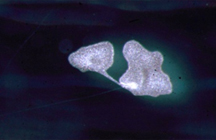
Trichoplax at the instant of division. They are truly flat, only about three cells thick.
Recently, jumbo Xenoturbella around 10 centimeters long have apparently been found off the US coast at depths of 2,000 to 3,000 meters. The oceans are filled with endless surprises and unfathomable mystery. As Prof. Nakano says, eyes shining, "Tiny creatures conceal giant riddles."
Article by Science Communicator at the Office of Public Relations
(Video) Moving Xenoturbella worms


